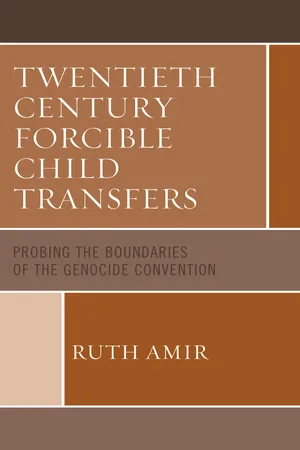
eBook - ePub
Twentieth Century Forcible Child Transfers
Probing the Boundaries of the Genocide Convention
- English
- ePUB (mobile friendly)
- Available on iOS & Android
eBook - ePub
Twentieth Century Forcible Child Transfers
Probing the Boundaries of the Genocide Convention
About this book
The current surge of displaced and trafficked children, child soldiers, and child refugees rekindles the virtually dead letter of the Genocide Convention prohibition on transferring children of one group to another.
This book focuses on the gap between genocide as a legal term and genocidal forcible child transfer as a catastrophic experience that disrupts a group's continuity. It probes the Genocide Convention's boundaries and draws attention to the diverse, yet highly similar, patterns of forcible child transfers cases such as colonial genocide in the US, Canada, and Australia, Jewish-Yemeni immigrants in Israel, children of Republican parents during the Spanish Civil War and its aftermath, and Operation Peter Pan in Cuba. The analysis highlights the consequences of the under-inclusive protection granted only to four groups.
Ruth Amir argues effectively for the need to add an Amending Protocol to the Genocide Convention to protect from forcible transfer to children of any identifiable group of persons perpetrated with the intent to destroy the group as such. This proposed provision together with Communications and Rapid Inquiry Procedures will highlight the gravity of forcible child transfers and contribute to the prevention and punishment of genocide.
This book focuses on the gap between genocide as a legal term and genocidal forcible child transfer as a catastrophic experience that disrupts a group's continuity. It probes the Genocide Convention's boundaries and draws attention to the diverse, yet highly similar, patterns of forcible child transfers cases such as colonial genocide in the US, Canada, and Australia, Jewish-Yemeni immigrants in Israel, children of Republican parents during the Spanish Civil War and its aftermath, and Operation Peter Pan in Cuba. The analysis highlights the consequences of the under-inclusive protection granted only to four groups.
Ruth Amir argues effectively for the need to add an Amending Protocol to the Genocide Convention to protect from forcible transfer to children of any identifiable group of persons perpetrated with the intent to destroy the group as such. This proposed provision together with Communications and Rapid Inquiry Procedures will highlight the gravity of forcible child transfers and contribute to the prevention and punishment of genocide.
Frequently asked questions
Yes, you can cancel anytime from the Subscription tab in your account settings on the Perlego website. Your subscription will stay active until the end of your current billing period. Learn how to cancel your subscription.
At the moment all of our mobile-responsive ePub books are available to download via the app. Most of our PDFs are also available to download and we're working on making the final remaining ones downloadable now. Learn more here.
Perlego offers two plans: Essential and Complete
- Essential is ideal for learners and professionals who enjoy exploring a wide range of subjects. Access the Essential Library with 800,000+ trusted titles and best-sellers across business, personal growth, and the humanities. Includes unlimited reading time and Standard Read Aloud voice.
- Complete: Perfect for advanced learners and researchers needing full, unrestricted access. Unlock 1.4M+ books across hundreds of subjects, including academic and specialized titles. The Complete Plan also includes advanced features like Premium Read Aloud and Research Assistant.
We are an online textbook subscription service, where you can get access to an entire online library for less than the price of a single book per month. With over 1 million books across 1000+ topics, we’ve got you covered! Learn more here.
Look out for the read-aloud symbol on your next book to see if you can listen to it. The read-aloud tool reads text aloud for you, highlighting the text as it is being read. You can pause it, speed it up and slow it down. Learn more here.
Yes! You can use the Perlego app on both iOS or Android devices to read anytime, anywhere — even offline. Perfect for commutes or when you’re on the go.
Please note we cannot support devices running on iOS 13 and Android 7 or earlier. Learn more about using the app.
Please note we cannot support devices running on iOS 13 and Android 7 or earlier. Learn more about using the app.
Yes, you can access Twentieth Century Forcible Child Transfers by Ruth Amir in PDF and/or ePUB format, as well as other popular books in Politics & International Relations & Family Law. We have over one million books available in our catalogue for you to explore.
Information
Table of contents
- Cover
- Half-Title
- Title
- Copyright
- Contents
- Preface
- List of Abbreviations
- Introduction
- PART I: Genocidal Forcible Child Transfer
- PART II: Historical Cases
- PART III: Conclusion
- Conclusion
- Bibliography
- Index
- About the Author